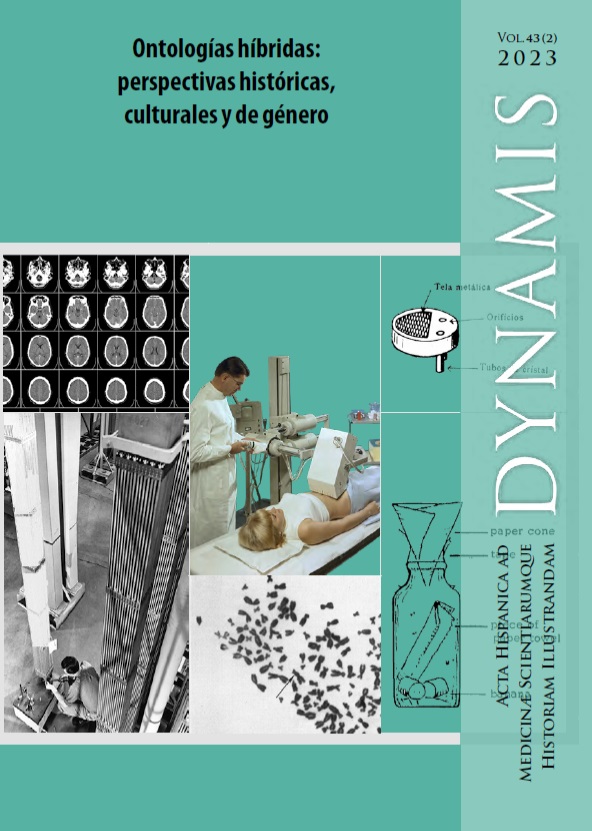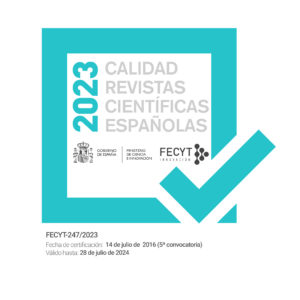The journey of Spanish uranium in the sixties: meanings and materialities of a hybrid object
DOI:
https://doi.org/10.30827/dynamis.v43i2.29441Keywords:
uranium, travel, Spain, Francoism, nuclear energyAbstract
In 1966, 137 tons of Spanish uranium ore arrived at the port of New Orleans from the port of Cádiz. In this paper, I want to use this trip, which involved political, industrial, and business agents as well as technical capabilities, to explore the uranium as a hybrid object - physical, technical and diplomatic. This material connected the interests of the Franco authorities, scientists, and businessmen from the electrical industry. It served the Franco regime in training researchers, in buying and importing technologies, methods and experimental practices, and in introducing ways to popularize atomic policies and ideologies from the United States. Uranium was a fuel that not only powered nuclear reactor but also fed new disciplinary spaces, modified landscapes, and sketched new industrial and administrative cartographies. Besides being a key piece of the Franco regime’s foreign policy —it was useful to the Spanish regime to align itself with prevailing Western thought on the civil uses of nuclear energy— it served internally to effectively abandon autarchic discourses and strengthen the power of the technocrats, who used atomic energy to transform Spanish electrical production. The materiality of uranium ore changed with travel and also its meanings.
Downloads
References
Adamson, Matthew. “Science Diplomacy at the International Atomic Energy Agency: Isotope Hydrology, Development, and the Establishment of a Technique.” Journal of Contemporary History 56, no. 3 (2021): 522-542. DOI: https://doi.org/10.1177/0022009421997888
Adamson, Matthew; Lino Camprubí y Simone Turchetti, “From the Ground Up: Uranium Surveillance and Atomic Energy in Western Europe” in The Surveillance Imperative. Geosciences during the Cold War and Beyond, editado por Simone Turchetti y Peder Roberts, 23-44. Palgrave Macmillan, 2014. DOI: https://doi.org/10.1057/9781137438744_2
Adamson Matthew y Roberto Lalli. “Global Perspectives on Science Diplomacy: Exploring the Diplomacy-knowledge Nexus in Contemporary Histories of Science.” Centaurus 63, no. 1 (2021): 1-16, DOI: https://doi.org/10.1111/1600-0498.12369
https://doi.org/ 10.1111/1600-0498.12369.
Amundson, Michael A. Yellowcake Towns: Uranium Mining Communities in the American West. Boulder, Colorado: University Press of Colorado, 2004.
Bleichmar, Daniela. Visible empire: botanical expeditions and visual culture in the Hispanic Enlightenment. Chicago: University of Chicago Press, 2012. DOI: https://doi.org/10.7208/chicago/9780226058559.001.0001
Bud, Robert. Penicillin: triumph and tragedy. Oxford: Oxford University Press, 2007.
Carbonell, Antonio. “Nota sobre los minerales de uranio”. Revista Ejército, 7 (1946): 77-78.
Clifford, James. Itinerarios transculturales. Barcelona: Gedisa editorial, 1999.
Comba, Antonio. “Los minerales de uranio y su tratamiento industrial”, in Uranio: curso de conferencias. Madrid: Memorias del Instituto Geológico y Minero de España, 1946.
Daston, Lorraine, ed. Biographies of scientific objects. Chicago: University of Chicago Press, 2000.
Drogan, Mara. “The Nuclear imperative: Atoms for Peace and the development of U.S. policy on exporting nuclear power, 1953-1955.” Diplomatic History, 40, no. 5 (2016): 948-974, https://doi.org/10.1093/dh/dhv049 DOI: https://doi.org/10.1093/dh/dhv049
Hecht, Gabrielle, ed. Entangled Geographies: Empire and Technopolitics in the Global Cold War. Inside Technology. Cambridge, MA: The MIT Press, 2011. DOI: https://doi.org/10.7551/mitpress/9780262515788.001.0001
Hecht, Gabrielle. Being Nuclear: Africans and the Global Uranium Trade. Cambridge, MA: The MIT Press, 2012.
Helmreich, Jonathan E. “The United States and the Formation of EURATOM”. Diplomatic History 15, no. 3 (I99I): 387-410. DOI: https://doi.org/10.1111/j.1467-7709.1991.tb00137.x
Hewlett, Richard G. y Jack M. Holl. Atoms for Peace and War, 1953-1961: Eisenhower and the Atomic Energy Commission. Berkeley; University of California Press, 1989. DOI: https://doi.org/10.1525/9780520329362
Ito, Kenji y Maria Rentetzi. “The Co-production of Nuclear Science and Diplomacy: Towards a Transnational Understanding of Nuclear Things.” History and Technology 37, no. 1 (2021): 4-20, https://doi.org/10.1080/07341512.2021.1905462 DOI: https://doi.org/10.1080/07341512.2021.1905462
Krige, John. “Atoms for Peace, scientific internationalism, and scientific intelligence.” Osiris 21, no. 1 (2006): 161-181. DOI: https://doi.org/10.1086/507140
Kyrtsis, Alexandros y Maria Rentetzi. “From Lobbyists to Backstage Diplomats. How Insurers in the Field of Third-Party Liability Shaped Nuclear Diplomacy.” History and Technology 37 (2021): 25-43. DOI: https://doi.org/10.1080/07341512.2021.1893999
López-Ocón, Leoncio; Víctor Guijarro y Mario Pedrazuela, eds. Profesores viajeros y renovación de la enseñanza secundaria en los países ibéricos (1900-1936). Madrid: Universidad Carlos III, 2018.
Lleonart, Alberto J. y Fernando Castiella. España y ONU: la cuestión española. Madrid: CSIC, 1978-2002.
Medhurst, Martin J. “Atoms for Peace and Nuclear Hegemony: The Rhetorical Structure of a Cold War Campaign,” Armed Forces & Society, 23, no. 4 (1997): 571-593. DOI: https://doi.org/10.1177/0095327X9702300403
New Frontiers of Science Diplomacy. Navigating the changing balance of power (2010). Royal Society & Association for the Advancement of Science, https://www.aaas.org/sites/default/files/New_Frontiers.pdf
Osgood, Kenneth. Total Cold War: Eisenhower’s secret propaganda battle at home and abroad. Lawrence: University Press of Kansas, 2006.
Oreskes, Naomi y John Krige, eds. Science and Technology in the Global Cold War. Cambridge, MA: MIT Press, 2014. DOI: https://doi.org/10.7551/mitpress/9780262027953.001.0001
Pimentel, Juan. Testigos del mundo: ciencia, literatura y viajes en la Ilustración. Madrid: Marcial Pons Historia, 2003.
Presas I Puig, Albert. “Science on the periphery. The Spanish Reception of Nuclear Energy: an attempt at modernity?” Minerva, 43 (2005): 197-218. DOI: https://doi.org/10.1007/s11024-005-2332-7
Presas I Puig, Albert. “La inmediata posguerra y la relación científica y técnica con Alemania,” in Cien años de política científica en España editado por Ana Romero de Pablos y María Jesús Santesmases, 173-210. Madrid: Fundación BBVA, 2008.
Rentetzi, Maria e Kenji Ito. “The Material Culture and Politics of Artifacts in Nuclear Diplomacy.” Centaurus 63 (2021): 233-243. DOI: https://doi.org/10.1111/1600-0498.12394
Romero de Pablos, Ana. “Poder político y poder tecnológico: el desarrollo nuclear español (1950-1975).” Revista CTS, 21 (2012): 141-162
Romero de Pablos, Ana. “Mujeres científicas en la dictadura de Franco. Trayectorias investigadoras de Piedad de la Cierva y María Aránzazu Vigón,” Arenal, 24, no. 2 (2017): 319-348.
Romero de Pablos, Ana. “Historia de una biblioteca atómica” in De la Guerra Fría al calentamiento global. Estados Unidos, España y el nuevo orden científico mundial, editado por Lino Camprubí, Xavier Roqué y Francisco Saez de Adana, 63-84. Madrid: Los Libros de la Catarata, 2018.
Romero de Pablos, Ana. “Knowledge that travelled between Italy and Spain during the Franco regime: the construction of radioactivity counters.” Manguinhos, Revista História, Ciências, Saúde, 26, no. 1 (2019), https://doi.org/10.1590/S0104-59702019000100015. DOI: https://doi.org/10.1590/s0104-59702019000100015
Romero de Pablos, Ana. Las primeras centrales nucleares españolas. Actores, políticas y tecnologías. Madrid: Sociedad Nuclear Española, 2019.
Romero de Pablos, Ana. “Atomic Routes and Cultures for a New Narrative on Franco’s Regime.” Culture & History Digital Journal 10, no. 1 (2021), https://doi.org/10.3989/chdj.2021.005 DOI: https://doi.org/10.3989/chdj.2021.005
Romero de Pablos, Ana y José Manuel Sánchez Ron. Energía nuclear en España. De la JEN al CIEMAT. Madrid: Ediciones Doce Calles/CIEMAT, 2001.
Roqué, Xavier y Néstor Herrán. “An autarkic science: physics, culture, and power in Franco’s Spain.” Historical Studies in the Natural Sciences 43, no. 2 (2013): 202-235. DOI: https://doi.org/10.1525/hsns.2013.43.2.202
Rubio-Varas, Mar y Joseba de la Torre. The Economic History of Nuclear Energy in Spain: Governance, Business and Finance. Palgrave Macmillan, 2017. DOI: https://doi.org/10.1007/978-3-319-59867-3
Rubio-Varas, Mar y Joseba de la Torre. “American Nuclear Training. Científicos, ingenieros y empresarios españoles en los Estados Unidos del desarrollo atómico,” in De la Guerra fría al calentamiento global. Estados Unidos, España y el orden científico mundial editado por Lino Camprubí, Xavier Roqué y Francisco Adana, 85-110. Madrid: Libros de la Catarata, Universidad de Alcalá de Henares, 2018.
Sánchez, Esther y Santiago López. Historia del uranio en España. De la minería a la fabricación del combustible nuclear, c. 1900-1986. Madrid: Sociedad Nuclear Española, 2021.
Santesmases, María Jesús. The Circulation of Penicillin in Spain. Palgrave McMillan, 2017. DOI: https://doi.org/10.1007/978-3-319-69718-5
Secord, James A. “Knowledge in Transit.” Isis 95 (2004): 654-672. DOI: https://doi.org/10.1086/430657
Swindell, G.E. “El transporte de los materiales radiactivos”. Boletín IAEA, 20, no. 5, 17-24.
Turchetti, Simone. Greening the Alliance: The Diplomacy of NATO’s Science and Environmental Initiatives. Chicago: Chicago Press, 2019. DOI: https://doi.org/10.7208/chicago/9780226595825.001.0001
Velasco Morgado, Raúl. “Pediatría y cultura de viaje: los pensionados españoles y la apropiación del laboratorio en la periferia, 1907-1939.” História, Ciências, Saúde-Manguinhos 26 (2019): 841-862, https://doi.org/10.1590/S0104-59702019000300007 DOI: https://doi.org/10.1590/s0104-59702019000300007
Viñas, Ángel. Los pactos secretos de Franco con Estados Unidos: bases, ayuda económica, recortes de soberanía. Barcelona: Grijalbo, 1981.
Zaidi, Waqar. Technological Internationalism and World Order: Aviation, Atomic Energy, and the Search for International Peace, 1920-1950. Cambridge: Cambridge University Press, 2021. DOI: https://doi.org/10.1017/9781108872416
Downloads
Published
How to Cite
Issue
Section
License
Copyright (c) 2023 Dynamis

This work is licensed under a Creative Commons Attribution-NonCommercial-NoDerivatives 4.0 International License.
Dynamis se encuentra adherida a una licencia Creative Commons Reconocimiento (by), la cual permite cualquier explotación de la obra, incluyendo una finalidad comercial, así como la creación de obras derivadas, la distribución de las cuales también está permitida sin ninguna restricción.

















